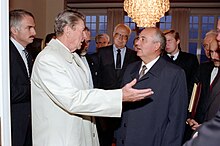Summit in Reykjavík
The summit in Reykjavík was the second summit meeting between US President Ronald Reagan and the general secretary of the Central Committee of the Communist Party of the Soviet Union (CPSU), Mikhail Gorbachev . It took place on October 11th and 12th, 1986 in Reykjavík , the capital of Iceland . Both states were in the Cold War . The talks focused on disarmament and peace between the United States and the Soviet Union. The two foreign ministers George Shultz and Eduard Shevardnadze also attended the summit .
Place of negotiation

The summit took place in the Höfði guest house on the outskirts of the capital Reykjavik. The simple white wooden house was the former French consulate (1909–1921) and the British embassy (1938–1952). The meeting was deliberately held simply, with no red carpet, no banquet and no national anthems.
Starting position
The leaders of the two superpowers first met in November 1985 at the Geneva Summit Conference . The friendly spirit of Geneva, meanwhile, has been weighed down by the alleged Nicholas Daniloff espionage affair.
In Geneva, the two heads of state decided to resume the arms control talks that had been interrupted at the end of 1983 (Geneva INF negotiations). The Soviets had deployed new medium-range nuclear missiles, the SS-20 , in the 1970s, threatening Western Europe . In 1979, NATO reacted with the NATO double resolution , which provided for the installation of new missiles and cruise missiles equipped with nuclear warheads - the Pershing II and BGM-109 Tomahawk - in Western Europe.
Summit course
In Reykjavík, Reagan tried to discuss not only disarmament but also human rights, the emigration of Soviet Jews and dissidents, and Soviet intervention in Afghanistan . Gorbachev wanted to limit the talks to arms control. He offered to halve the amount of all strategic nuclear weapons and dismantle all medium-range missiles from the two military blocs. He renounced the inclusion of British and French nuclear weapons, allowed disarmament controls on Soviet soil and agreed to make human rights a key issue at future summits. With this he linked the demand that the US should limit its Strategic Defense Initiative (SDI) , a space-based missile defense system, to pure laboratory tests. Reagan refused.
The American delegation responded by proposing that all ballistic missiles be abolished within ten years, but demanded the right to strategic defense SDI against the remaining threats. Gorbachev then proposed that all nuclear weapons be abolished within a decade. However, he referred to the desire to strengthen the Anti-Ballistic Missile Treaty (ABM Treaty) and added that any research in the field of SDI must be limited to laboratories for the ten-year period in question. Reagan argued that any reasonable interpretation of the ABM treaty allowed his proposed SDI research. He also referred to his promise to the Americans to protect them through SDI. He also promised to share SDI technology. Gorbachev doubted this, as the Americans would not even share oil drilling technology.
Summit exit
Despite four rounds of talks, the negotiations failed at the last minute due to irreconcilable differences over the question of the American space research program SDI. Gorbachev insisted on limiting SDI research to the laboratory for a period of ten years. Reagan refused and asked Gorbachev if he really wanted to jeopardize a historic opportunity over a single word "laboratory experiment". Gorbachev stressed that it was a matter of principle and the summit was over: no agreement, not even a declaration of intent. The chance of the century to conclude the most comprehensive disarmament package of the nuclear age in one big stroke was wasted.
Nevertheless, the summit gave both parties the opportunity to explore how far the other side's concessions would go. A significant step forward in arms control was Gorbachev's agreement to negotiate on-site controls, an ongoing American demand that had not been met in the partial test ban treaty of 1963 or the ABM and SALT-I pact of 1972. In addition, human rights were discussed constructively for the first time.
Before returning to Moscow , Gorbachev resorted to a ruse. Since he had to free the ailing Soviet Union from the enormous expenditure on armaments, he could not afford to fail the summit domestically. At a press conference called at short notice, Gorbachev described the Reykjavik summit as a success. Back in Washington, Reagan was forced to act. He had no choice but to portray the meeting as a breakthrough as well: “They were good conversations. We are ready to pick up where we left off. "
Consequences of the summit
Despite the apparent failure, participants and observers described the summit as a tremendous breakthrough that ultimately made possible the Intermediate-Range Nuclear Forces Treaty ( INF ), which was signed at the Washington summit on December 8, 1987.
literature
- Jack Matlock : Reagan and Gorbachev: How the Cold War Ended. Random House, New York 2004.
Individual evidence
- ^ Annual review 1986: Summit in Reykjavík on tagesschau.de
- ↑ October 11, 1986 - Disarmament summit begins in Reykjavik On: WDR from October 11, 2010
- ^ The Reykjavik Summit . The Reagan Vision. Retrieved September 15, 2014.
- ↑ The big ones turn in circles In: Die Zeit of September 26, 1986
- ^ A b James Mann, The Rebellion of Ronald Reagan: A History of the End of the Cold War (New York: Penguin Group, 2009), 45.
- ^ Philipp Gassert and others: Second Cold War and Peace Movement. Munich 2011, p. 88.
- ^ Jack F. Matlock Jr., Reagan and Gorbachev: How the Cold War ended (New York: Random House, 2004).
- ↑ Christoph Bertram: The bitter truth about the summit: In Reykjavik a historic opportunity was wasted In: The time of October 17, 1986


